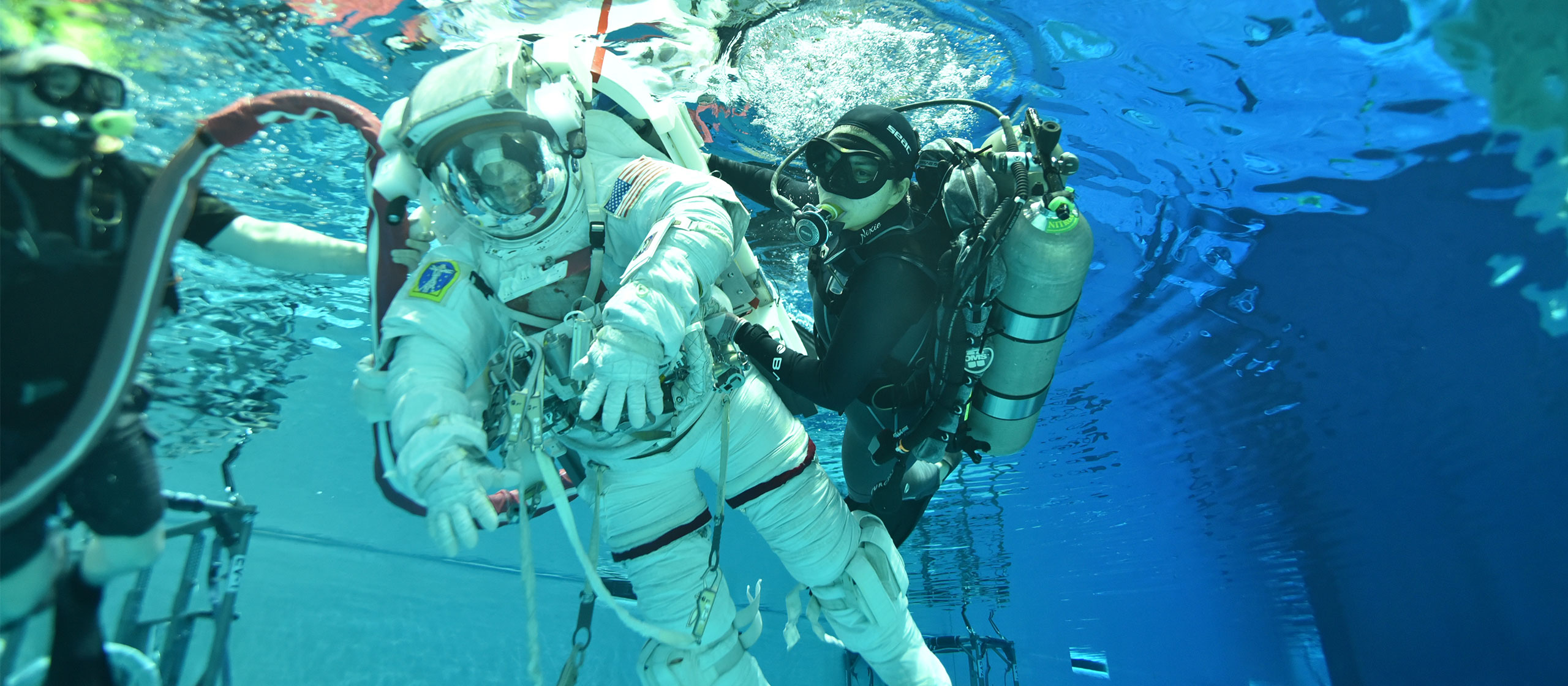Dive stories
Exploring the Depths: World’s Deepest Pools as Cutting-Edge Testing Centers
Over the past few years, the number of deep and large diving pools has gradually increased around the world, to explore rec / tech / freediving in a confined and safe space. However, by virtue of their dichotomy (by being both an extreme environment, and one that can be easily controlled); these facilities have serendipitously become the best place to train astronauts, conduct ecophysiology research, and test the latest submersibles. In this article, GUE’s 2022-23 NextGen Scholar, and sub-sea ambassador for Blue Abyss, Jenn Thomson, highlights the other uses of these deep pools around the world — showing that it’s about more than just the depth!
So, you want to work in a swimming pool? And no, I’m not talking about an Olympic-size swimming pool, the dimensions of which are typically 50m long, 25m wide, and 2m deep. I’m talking about the deep diving pools (initially designed for scuba diving training in a controlled environment), that have been popping up over the past 25 years or so.
Now, there is not (of what I can see) an official / global depth threshold to cross to become a designated deep diving pool. Around the world, there are a few pools that posit themselves as deep, which are between the 12-30m mark, however, Florine Quirion, a previous InDEPTH writer on the deep pools around the world, cites that only those in the sub-30-metre range can earn the title of “deep scuba diving pools”. Thus far, there are only 4 well-known facilities that range in depth from 30m to 60m (albeit with some exciting developments on the horizon!).
So, from 2 to 23 MILLION Litres of water, from 12 to 60m depth, here are the “top trump” stats of some of the deepest, and largest pools around the world:
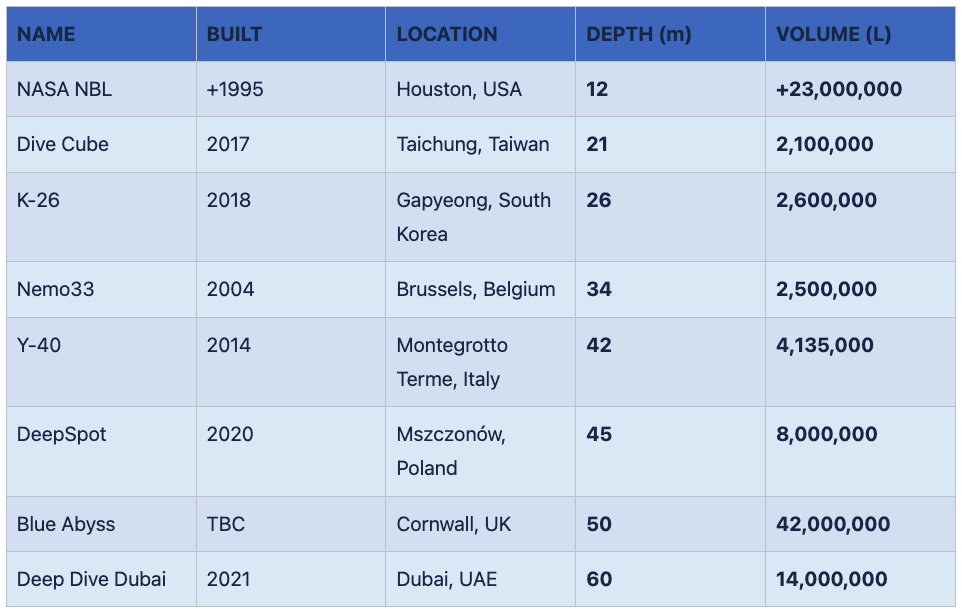
But, there are more to these pools than meets the eye. As an environment where everything is monitored (for example variables such as depth, timing, duration and temperature), these facilities can become a living laboratory, which one can use for astronaut training, space development, and studying human physiology in extreme environments. So, let’s do a deeper dive into some of the world’s deepest and largest pools – but shifting the lens away from scuba, and into the other research that is being conducted in these (literally) breath-taking facilities.
NEMO33
Located in Belgium and designed to bring the tropical waters to the colder climates of Europe, Nemo33 also regards itself as one of the safest, cheapest and sustainable deep diving pools. With the use of 5 depth platforms, Nemo33 also uses its pool to conduct physiology research by partnering with Divers Alert Network (DAN) Europe and diving physiologist Prof. Costantino Balestra.
In one study, 14 divers dove to 33m for 20 minutes, and for almost 2 hours post-dive, they were examined with an echocardiogram – an ultrasound that one uses to see heart structure and function. The aim was to detect abnormal bubbles of gas (also known as venous gas emboli (VGE) in the divers’ cardiac systems, as a precursor for potential decompression sickness (DCS). However, it was found that there was both intra- and inter-variability in VGE score and bubble accumulation over time. Basically, individuals vary in their risks for DCS, and even the same person can vary in their risk on different days Papadopoulou et al. (2018). So, DAN is continuing this study to ascertain the reasons for variability in VGE. However, we already know that a good blood vessel function can help decrease the propensity of VGE. So, are there ways to easily precondition divers to increase their blood vessel functionality? Another group of researchers actually examined this – by making divers bounce on mini trampolines for 2 minutes, 15 minutes before diving at Nemo 33. And it worked – VGE was significantly reduced in the trampolining scuba divers due to cardiovascular preconditioning! See Lambrechts et al., 2022.
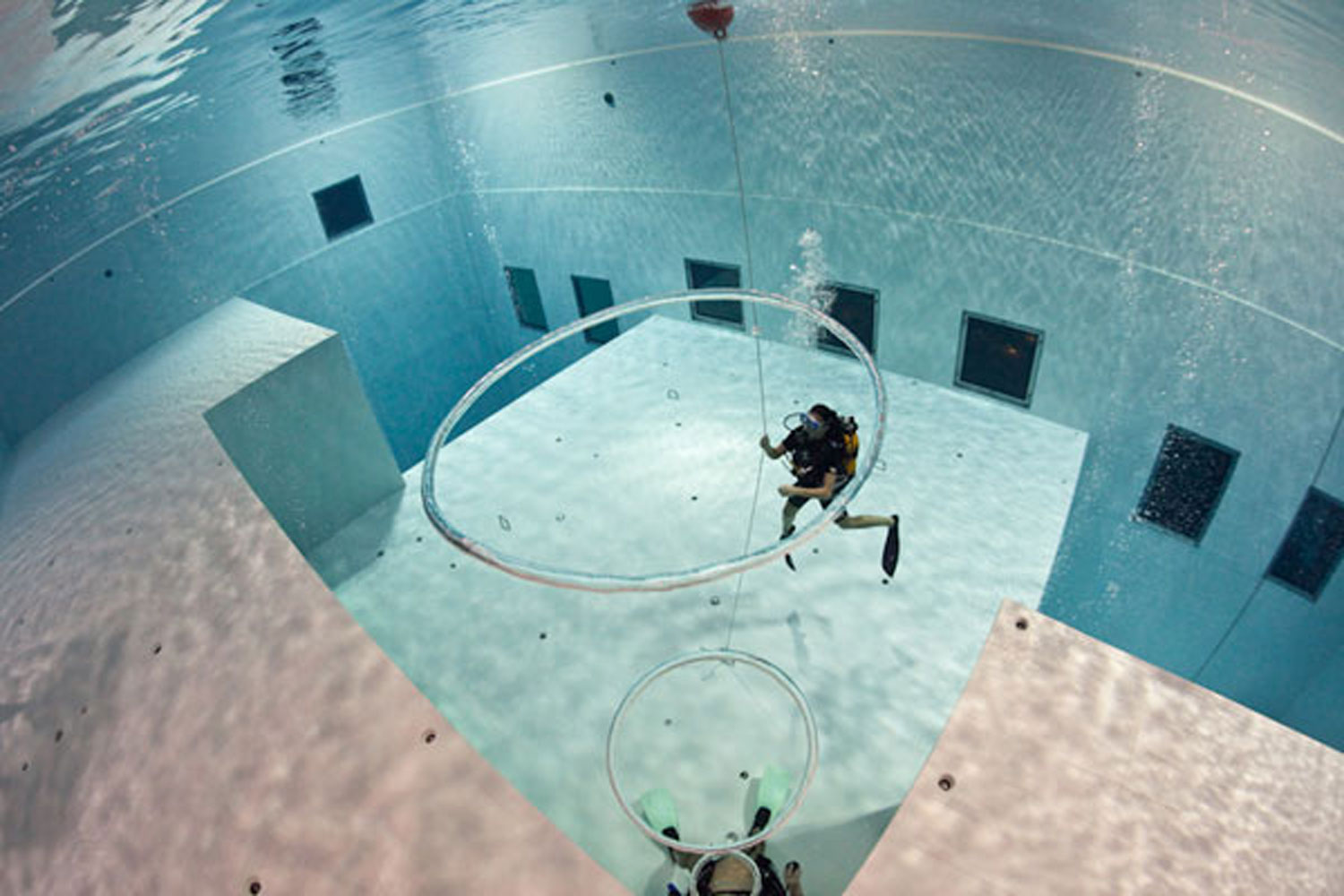
Photo credit: nemo33.com
And – potentially one of my favourite studies about improving blood vessel function: when a group of divers ate 86% dark chocolate before a dive at Nemo 33, and their flow-mediation dilation (FMD) rate was measured afterwards. This was then compared to a control group that ate no chocolate. FMD is a test to see how efficient the arteries / veins are at vasodilating. It is important to have wide open blood vessels (characterised by a high FMD rate), to reduce the risk of blood clots occurring, or to present blockages in the cardiovascular system. After diving, it was found that the chocolate-eaters had significantly better FMD results after diving, than those who did not eat chocolate. It is thought that the polyphenols in dark chocolate stimulate different chemicals in the blood, to help with vasodilation (Theunissen et al., 2015). The take home message is that dark chocolate is good for scuba divers!
There also is a plethora of scientific papers which have used Nemo33 as a study site, including work on heart rate variability (the difference in timings between heart beats) in open circuit divers compared to rebreather divers (Lafère et al., 2021), and investigating the links between diving and several eye abnormalities (Deleu et al., 2022).
Y-40
Y-40 is rapidly becoming an interdisciplinarity research / testing / performance site, in not only the sciences but in the arts as well. Featuring seven platforms at different depths all the way to the bottom, Y-40 also prides itself on being the largest dive centre in the world, and one of the hottest (34°C, thanks to naturally-occurring, geothermally heated water). It also hosts walk-through tunnels and underwater lighting studios for brands to come and make videos – like this!

Photo credit: Rino Sgorbani
In 2018, the beer brand “Desperados” hosted one of the deepest underwater parties in the world at Y-40 – in collaboration with the DJs Peggy Gou and Artwork. Playing in the underwater tunnel, a sound system linked to seaTREK diving helmets meant that the party-goers (who were all submerged at the bottom), were able to listen and “dance” to the music. Even so, the sound system had to be modified so the listeners could feel the bass – even underwater at depth! In addition, several researchers from University College London (headed by experimental psychologist Dr Daniel Richardson), measured the participants’ moods and levels of creativity before and after the event. The participants rated their emotions on a “Mood Introspection Scale”, and then underwent various tests for imagination such as an “Incomplete Figure Task” – completing a drawing of something new, and a “Remotes Associates Task” – finding words that link seemingly separate concepts. Their research showed that new experiences can stimulate divergent thinking and boost the creative process (Richardson et al., 2022).
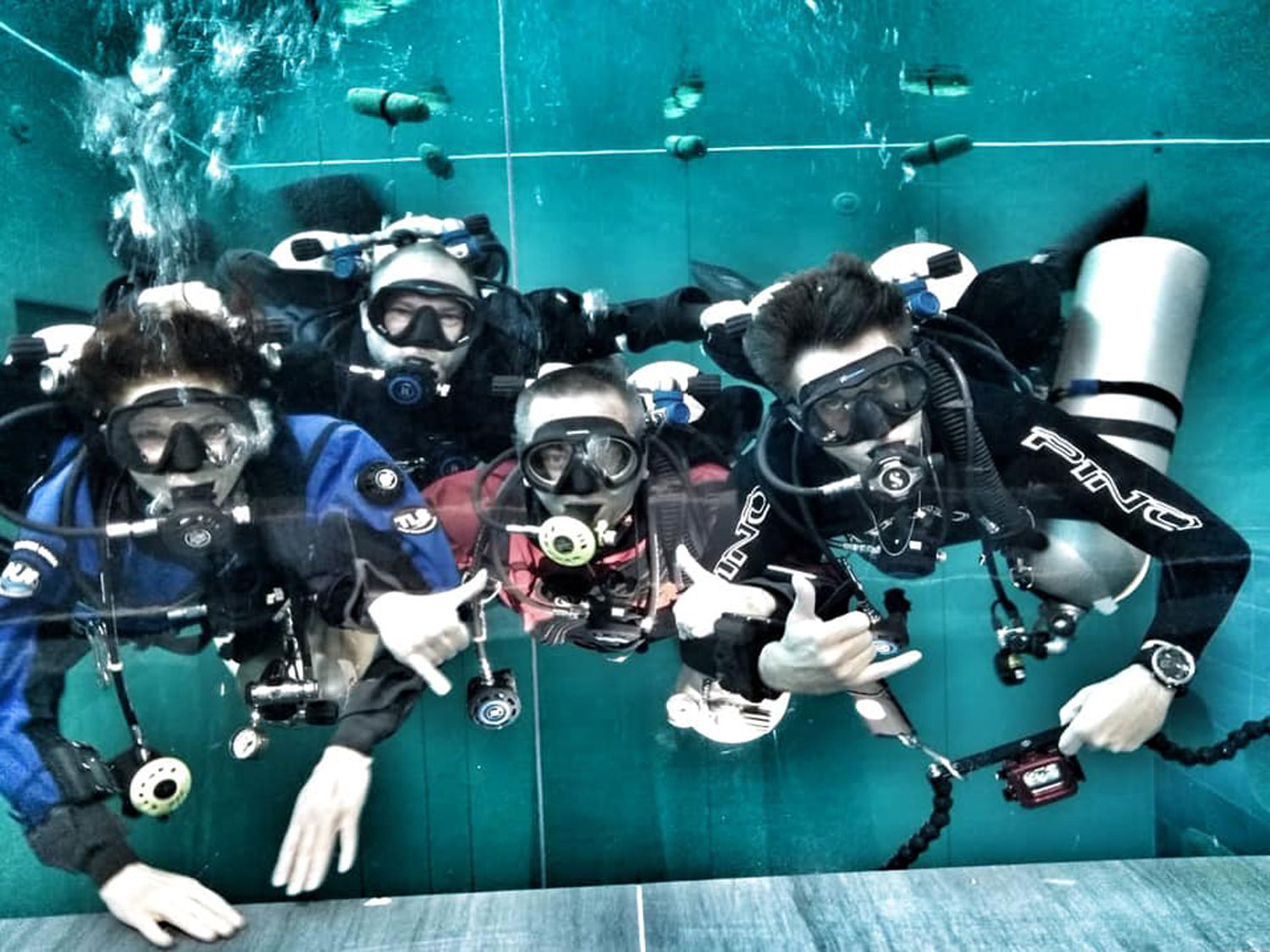
Photo credit: y-40.com
The Y-40 Open Lab seeks to bring together the disciplines of space, medical and physical sciences in the marine environment. Here in the pool, the University of Padova tested the electronics for the JUNO experiment (the Jiangmeng Underground Neutrino Observatory) – the largest neutrino observatory in the world. Y-40 was the perfect place to test this piece of equipment, as indeed part of the detector would be submerged and in conditions similar to Y-40. Neutrinos are the most abundant particles in the universe, have no charge, and very little mass. This experiment was important, as researchers in China want to use JUNO to study atmospheric solar neutrinos (i.e. these particles in space!). Check out a video about it here.
Y-40 was also the first pool where DAN Europe Researchers conducted in-water blood draws at 40m depth. This was performed on a group of divers who previously had covid-19, and research is ongoing to see how (post-illness), their diving physiological parameters were affected by this virus. The researchers also paired this with lung and heart ultrasounds, as well as using something called a DiveSense tracking device, to determine ascent speed / body positioning in the water in real time.
There are also a plethora of papers that have used Y-40 as their study site, including developing learning tools for underwater hyperbaric medicine (Paganini et al., 2021), various studies on oxidative stress after diving (Marchetti et al., 2022) (Mrakic-Sposta et al., 2019); showcasing that professional freedivers can have little symptoms when facing extreme hypoxia (Bosco et al., 2020), and on relationships between white blood cell counts and VGE (Cialoni et al., 2022).
NASA NBL
Ocean and space sciences are inextricably linked due to their extreme environments, the technological advances we must make to survive in these regions, and the desire to explore the unknown. However, to be prepared, astronauts need a large training pool. The most recognised example is the National Aeronautics and Space Administration’s Neutral Buoyancy Lab (NASA NBL) in Houston, Texas – one of the world’s largest indoor pools thus far (of dimensions ~60 x 30 x 12m, and a volume of over 6 million gallons of water). So, even if this is not a ‘deep pool’ per se, the volume of water it carries – and the testing capabilities it provides – is worth talking about! The NBL’s aim: to provide astronauts with a mock-up of the International Space Station (ISS). Here, they can feel what it would be like to conduct real Extra-Vehicular Activities (EVA’s), and also learn where different modules are on the ISS itself (ie how to traverse across the space station, so it is easier in out-of-this-world situations).
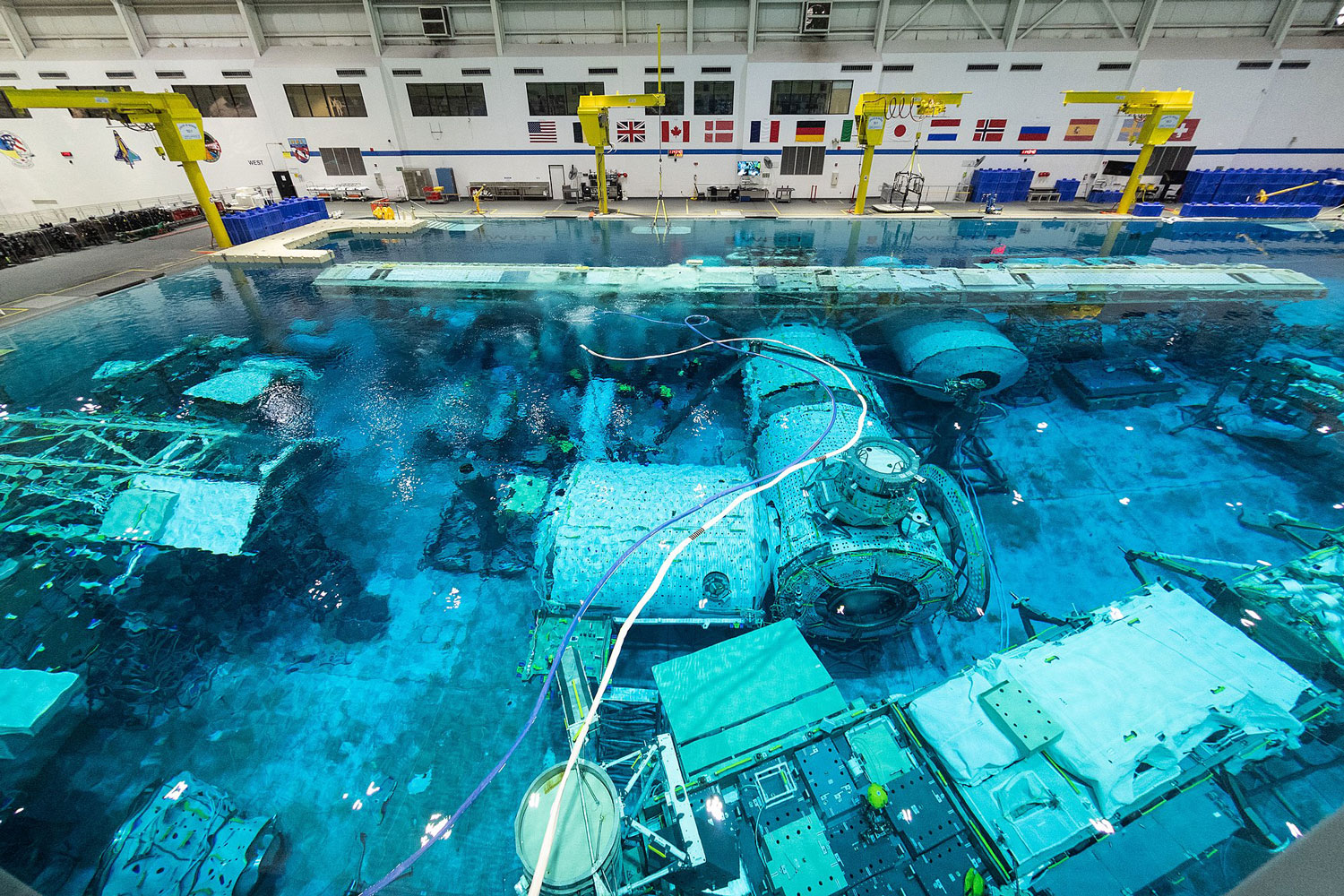
Photo credit: NBL Utility Dive Team. Divers photographed include Valeria Turcios, Andrew Smith and Emily Cox – shared with permission from NASA
Microgravity is what astronauts experience in space when they float around inside the ISS as if they were weightless. On Earth, we currently cannot mimic the microgravity environment for a long time, thus the NBL is currently the best way to train astronauts, although neutral buoyancy does not equate to microgravity. This is because gravity will still act upon the astronauts underwater, and training in the pool is much harder than on the ISS! Even moving tools underwater is harder due to the drag / weight that each instrument provides in the pool. Indeed, when astronauts come to do actual EVAs, they report how much easier it is to move around in space after conducting NBL training, and how delicate they must now be when carrying heavier objects!
An astronaut training dive is a massive operation which takes 2 dive teams on twinsets; the first group will be in-water for hours 1, 2, 5, and 6, and the second team will jump in for hours 3 and 4. All divers and astronauts are breathing nitrox at EAN46. This is most important for the astronauts themselves, to stop them from going into deco after their long stint in the pool – especially as their spacesuit is pressurised to ~ 4psi at the surface already (thus exacerbating things at depth!). When the astronauts are craned into the pool, safety divers must make the 300 lb spacesuits neutrally buoyant in the water – which will leave the astronaut in a head-up position at a 45-degree angle (the working position on an EVA in the ISS). This requires putting weights and foam on different parts of the body to achieve neutral buoyancy – but the body is still able to hover in the water column at this desired position. This procedure is called the weigh-out – and is individual to each astronaut.
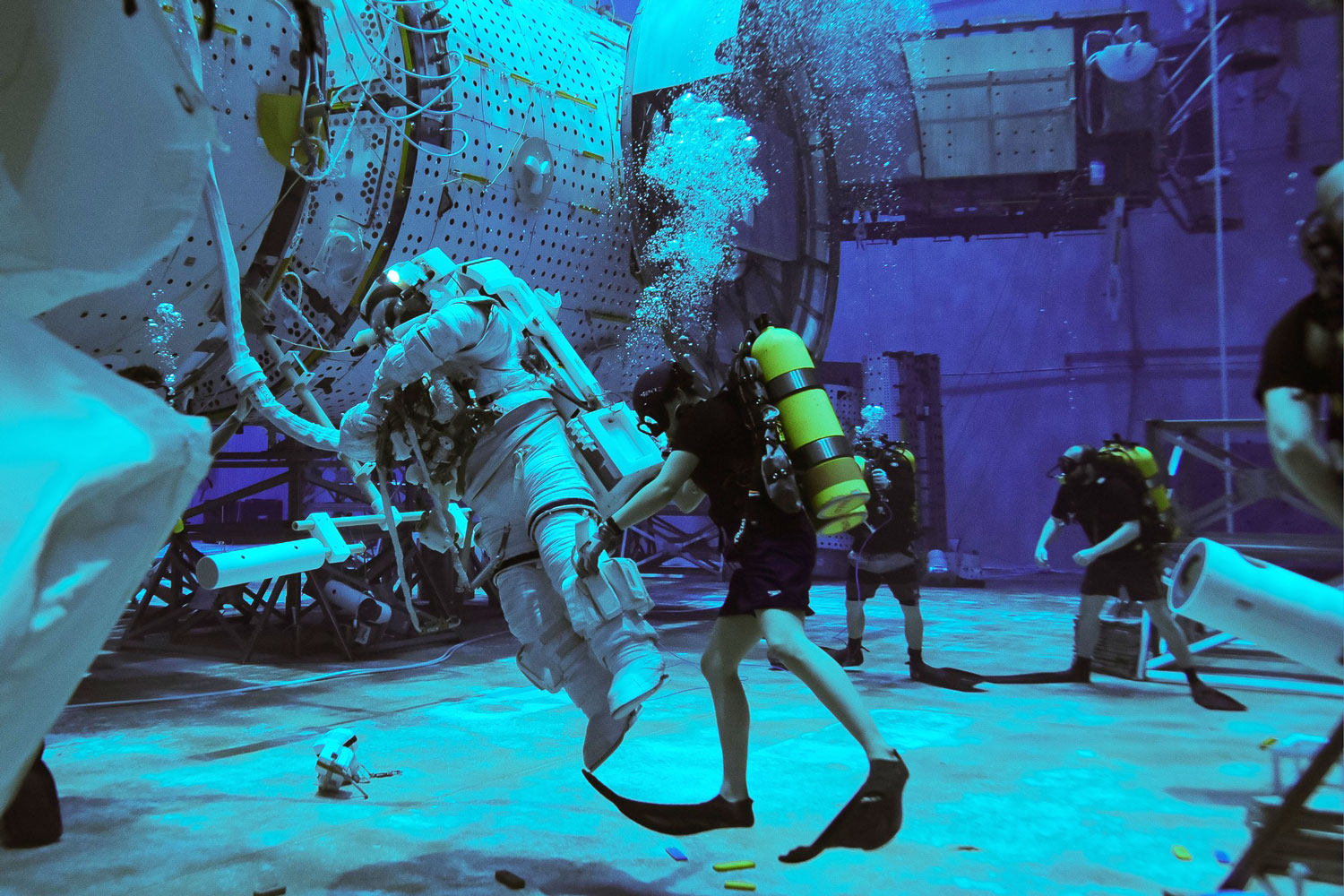
Photo credit: NBL Utility Dive Team. Divers photographed include Valeria Turcios, Andrew Smith and Emily Cox – shared with permission from NASA
However, the NBL is also now useful for simulating environments for NASA’s Artemis program – the return to the moon. Putting boots on the lunar surface is part of the Artemis III mission, scheduled for 2025/2026, and so they need to practise! By putting rocks and sand at the bottom of the NBL; and changing the weigh-out to make the astronaut a bit heavier but also “bouncier” – divers can recreate 1/6th gravity environment akin to the moon’s surface. Now with the simulated environment of the moon – astronauts can practise geological sample collection protocols here on Earth, along with the new spacesuits designed for the moon as well.
The future – Blue Abyss and Deep Dive Dubai
A concept initially formalised years ago, but now groundworks are finally being tested! Sea-to-Space company Blue Abyss is wanting to build the largest pool in the world, and one of the deepest, with plans made for a 50m x 40m x 50m pool.The design will be of several steps, which will allow multiple companies to use the pool at the same time. For example, the pool would be big enough to test small Remotely Operated Vehicles (ROVs) in a controlled environment, even offering the ability to change lighting and currents to simulate different conditions at different depths. ROVs are usually deployed to take images of the seabed, collect samples and explore the ocean at depths inaccessible to humans. Their capacity to work well in extreme environments is fundamental, hence knowing that they can perform in-water before expeditions will be a massive bonus. Blue Abyss would also be big enough to house mock sections of the ISS, again to help expand the opportunities for astronaut training.
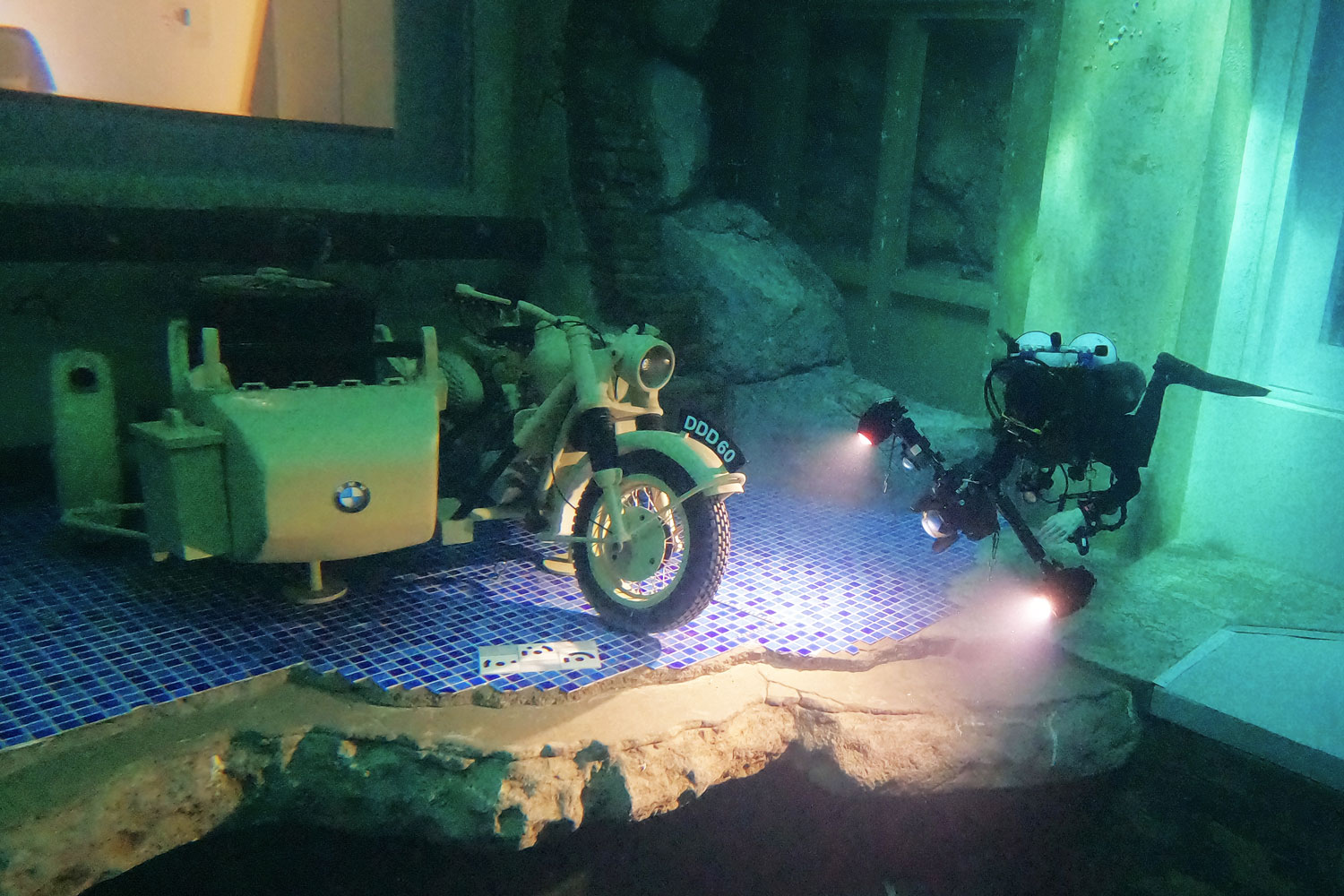
Photo credit: Nevcan Uludas
Blue Abyss’ target market is truly multi-faceted, with the pool not only positioned as a scuba training centre, but as a place where film crews, astronauts, engineers, archaeologists, and human performance experts have the storage facilities to come and work. In this sense, the in-water research in the pool will be enhanced by the facilities directly in the pool’s vicinity – one of the reasons why this building will be so unique. For example, Blue Abyss aims to hold a complete set of astronaut training tools (including microgravity simulation suites, centrifuges, and an airstrip for parabolic flights); alongside an extreme environment research lab (called the Kuehnegger Human Performance Centre, or KHPC). KHPC will sport hyper and hypobaric chambers, to aid research in biomedicine, sports rehabilitation, and human altitude science. Topping off all of this would be a media and education centre on site to inspire the next generation of explorers and scientists.
And of course, we cannot finish without mentioning the current deepest pool in the world. At 60m, Deep Dive Dubai changed the landscape of what swimming pools can provide for the rec / tech / freediving markets (literally – by building a sunken city instead of plain walls). Although only open a year, it is also the study site to test something called the “DANA Health, Sports Monitoring and Advanced Telemedicine”, led by researcher Dr Alessandro Marroni. The plan is to try and develop a form of diving telemedicine, in which real-time physiological variables – such as blood chemistry, decompression propensity, heart rate etc – are recorded from remote locations (as well as the dive profile in real time). This is conducted using a t-shirt with smart sensors in the fabric. If problems are detected, medical staff can assist even if they are far away from the patient. Check out more here.
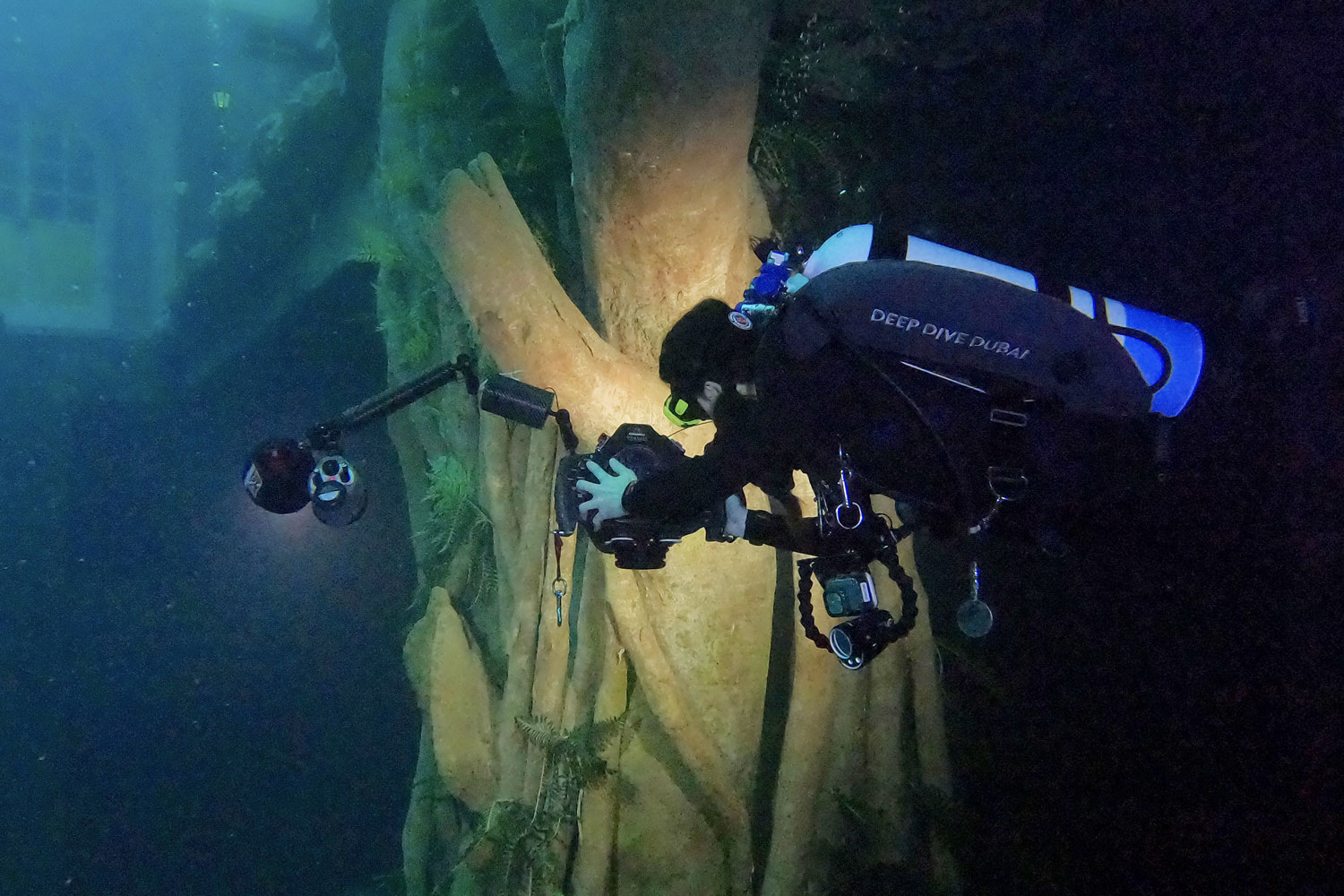
Photo credit: Nevcan Uludas
All in all, the types of research that deep pools can conduct are exceedingly wide ranging, and dare I say – we have barely dipped below the surface in terms of their potential! And imagine what could happen if we link up all the pools around the world – making a global network of next-generation extreme testing facilities. Think about all the breakthroughs that could be made in the space / marine / technology sectors, by virtue of everyone sharing knowledge in the same environment. The opportunities for interdisciplinary collaboration, development and inspiration are unparalleled. However, although only a dream for now – let’s stay tuned for future updates from all these sites, as I am sure that there are many more discoveries to be made!
DIVE DEEPER
- InDEPTH: Deep Dive Dubai—The Deepest Pool In The World Is Not A Pool by Jesper Kjøller
- InDEPTH: Size, err Depth, Matters: Why Do Pools Keep Breaking Records? By Florine Quirion
- Alert Diver.eu: Could optimising a diver’s hydration and temperature improve their decompression safety? by Michael Menduno
About the author
Jenn Thomson is the 2022-2023 NextGeneration Scholar for Global Underwater Explorers – currently on a global mission to highlight the roles that recreational scuba can play in scientific operations – and to provide inspiration for young upcoming divers! She is also a scientific diver, illustrator, and diverse field researcher specialising in the exploration of extreme environments. In 2022, she lived in Saudi Arabia for a year, and spent 5 months on an at-sea mission aboard the OceanXplorer, working as a logistic coordinator and expedition scientist on the eDNA, deep-sea coral, and megafauna teams. As an ambassador for sea-to-space company Blue Abyss, Jenn is helping to create a network of next-generation extreme environment, R&D and training centres around the world. She has radio-tracked everything from elephant shrews to elephants.
Connect with her:
- NextGen Blog – GUE — Jenn
- Instagram: @jennelizabeththomson
- Email – [email protected]


